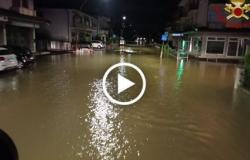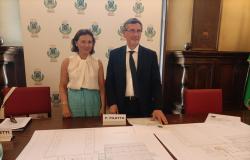
The Balkans are an important connection for many refugees from the Middle East and central-northern Africa heading towards the European Union
The Balkan Route has become one of the major passages undertaken by migrants in their exodus to reach Europe. Over time, the Route has played a fundamental role in the metamorphosis of migratory phenomena, transforming the Balkans into an important connection for many refugees from the Middle East and central-northern Africa heading towards the European Union. The Balkan Route continues to be a privileged route. In fact, Montenegro appears to be a transit destination for entry into Europe.
Caritas Marche went to the Balkans for a trip to study the Balkan Route and learn about the activities and projects of the local Caritas. It was a Press-Trip included within the project “Remap” which already a year and a half ago brought several young people from the dioceses of the Marche to visit the people hosted in the camps in Bosnia.
In the first stop in Montenegro, in the dioceses of Kotor and Bar, the delegate of Caritas Marche, Marco D’Aurizioand the director of Caritas Ancona-Osimo, Simone Breccia, they lived significant experiences such as visiting the Center for Asylum Seekers and meeting several people from the territories of Ukraine and Russia. Caritas was born in the country following the 1979 earthquake, developing an emergency network to support the population. In the 1990s, a structured group of volunteers and supporting professionals began to form. It currently offers care services for many elderly people and carries out social inclusion activities to support people with disabilities.
Mgr. Rrok Gjonlleshaj, archbishop of Bar and administrator of the diocese of Kotor, greeted the Marche delegation: “I am grateful to have had the opportunity to meet the members from the Italian Caritas and to have shared with them the experiences of our work in previous periods. As a local Church we are happy to have the opportunity to cooperate and share our mission that should be undertaken here in Montenegro. Today we are in front of the statue of the Virgin of the Holy Spirit and in this sense we hope that the Holy Spirit follows our activities and continues to inspire our work for the coming years. The role and importance of Caritas are very present here in Montenegro as part of the local Church, to transfer its social mission into everyday activities, following the basic and concrete laws that are transmitted by Caritas to people in need”.
The director of Caritas Montenegro, Marko Djelovicand the director of Caritas Kotor, Fr Zeljko Paskovicpresented some assistance projects for the local population such as the popular kitchen of Tivat or the reception centers of Bar. On the migrant issue, the situation has varied over time, the Ukrainian emergency has changed the conditions of reception, in fact dozens of thousands of refugees have arrived in the region to obtain international protection.
In Serbia, since the beginning of the emergency, around 19 refugee camps have been activated which have welcomed thousands of migrants; here the humanitarian situation is certainly better than in other areas in the Balkan context. This is because the Serbian Republic was involved in the migration emergency right from the start. However, there has been a clear reduction in reception centers from 19 to around 6, far from European borders.
Regarding the definition of migratory flows, Daniele Bombardi of Italian Caritas in the Balkans declared: “It is very difficult to make predictions because the ‘Route’ has shown in recent years to change continuously, perhaps the prediction is precisely that of unpredictability. The flows depend on the socio-political situations of the destination country and on how welcoming or how repelling the EU is at the borders, so the Balkans find themselves between a rock and a hard place and have little impact, because they see people passing through their territory from the countries most in difficulty trying to reach Europe. Caritas is also present along the entire Route in all countries, from Turkey to Serbia with services to people regardless of how many there are or what profile they present.”
Caritas Marche’s journey to deepen knowledge of the Balkan Route ended with the Trieste stop. The meeting with father Giovanni La Manna, former president of the Astalli Center in Rome and director of the diocesan Caritas of Trieste, made it possible to get to know the local Church and the other local realities that have been put in place to address this phenomenon, i.e. planning reception, medical assistance, eating and sleeping services. In fact, Trieste is a place of transit, around 7,000 people have arrived in the last 6 months, a decrease compared to last year. These people do not want to stay in Italy and Trieste, many (about 80%) in fact stop for a few days in order to continue their journey to other European countries.
The first landing in Italy of the Balkan Route is located in Trieste.
Attention is focused on the Silos, a completely abandoned building located next to the central station, near Piazza della Libertà, which sees volunteer associations working every evening to care for those who manage to cross the borders of the Balkan countries. In fact, that square renamed “of the world” has become one of the symbols of welcome of this city, thanks to the service of the “Linea d’ombra” association which provides initial and indispensable assistance to migrants every evening. Among the activists of the association there is Lorena Fornasir, who stated: “I practice care as a political gesture and I am in the square of the world caring, with other volunteers, because care starts from the body. In this square the first encounter is with the bodies of pain, which bear witness to the violence of the borders. They give us back broken, fractured bodies. In this historical phase we encounter bodies tortured by the Bulgarian and Croatian police who have always practiced torture in a scientific way, breaking limbs, breaking the body in order to make these boys invalids. Before they begin to attempt a new journey to Europe they must recover from both physical and psychological traumas.” The journey ended by entering the “Silos”, an indecorous, terrible place, in which migrants camp in dramatic conditions, among waste and mice, without any service. Words are limited to describe the place, the sense of shame at the lack of dignity and humanity.





